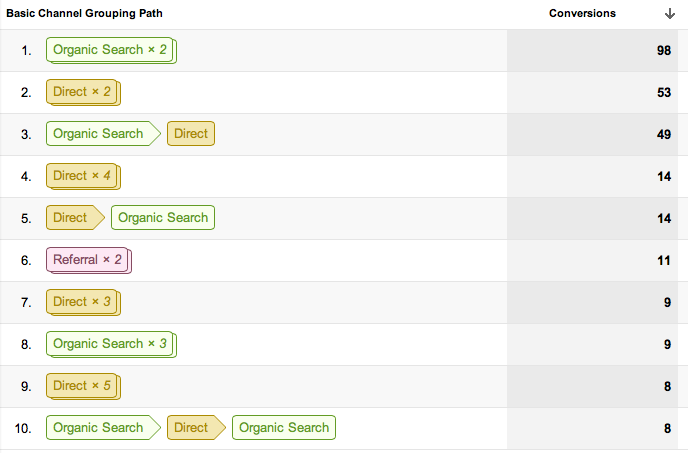Discover What Data Is Google Analytics Goals Unable to Track
Discover What Data Is Google Analytics Goals Unable to Track
Blog Article
Debunking Google Analytics Limitations: Discover What Data Goals Can not Track
In the realm of electronic analytics, Google Analytics stands as a powerful device that offers beneficial insights right into web site efficiency and user behavior. From the intricacies of individual interaction with dynamic content to the intricacies of cross-device individual trips, these constraints shed light on locations that may continue to be obscured from traditional analytics point of views.

User Communication With Dynamic Web Content
Individual interaction with vibrant web content plays an essential role in recognizing customer behavior on web sites and enhancing the general customer experience. Dynamic content refers to components on a webpage that can alter without the requirement for a full page reload. This includes interactive aspects such as pop-ups, sliders, forms, and videos that react to user activities in real-time. By tracking customer interactions with vibrant material, web site owners can acquire important understandings into customer interaction, preferences, and behaviors.
Google Analytics uses different tools to track customer communications with dynamic material, such as event monitoring and virtual pageviews. Occasion tracking allows you to keep an eye on certain user activities, like clicking a switch or enjoying a video clip, offering information on exactly how individuals interact with dynamic aspects. Digital pageviews can be made use of to track interactions that do not cause a brand-new web page tons, offering a thorough sight of user interaction with vibrant material. By examining this information, site proprietors can make enlightened decisions to boost individual experience and drive conversions.
Cross-Device Individual Journeys
Just how can modern analytics tools track the complicated paths customers take across numerous tools in their on-line journeys? Cross-device user journeys offer a significant obstacle for tracking and evaluating customer behavior properly. As customers connect with applications or web sites utilizing various tools such as tablets, desktop computers, and smart devices, it ends up being crucial to comprehend how they relocate in between these platforms to maximize customer experience efficiently.
Google Analytics faces restrictions in tracking cross-device customer trips due to privacy worries and technological restrictions - what data is google analytics goals unable to track. While it can supply understandings right into individual gadgets' interactions, tracking a smooth customer journey throughout multiple devices continues to be an obstacle. This restriction can cause incomplete information and fragmented user understandings, making it tough for businesses to develop a unified sight of the consumer journey
To address this problem, companies can use sophisticated analytics tools that use cross-device tracking capacities, allowing them to obtain an extra all natural understanding of user habits. By leveraging these devices, businesses can connect the void in tracking cross-device customer trips and optimize their electronic methods for a smooth customer experience.
Offline Conversions and Acknowledgment
As services navigate the difficulties of tracking cross-device customer trips, one more crucial facet to think about is the realm of offline conversions and attribution in the realm of information analytics. While Google Analytics provides important insights into online user behavior, it fails when it concerns tracking conversions that occur offline. This constraint poses a substantial difficulty for services that have both online and offline sales channels.
Offline conversions, such as acquisitions made in physical shops or through call facilities, are necessary to comprehending the total consumer trip. Without the my link capacity to connect these offline conversions to specific on-line interactions, services might have a hard time to precisely determine the effect of their electronic marketing efforts.
To address this space, organizations can discover alternative remedies such as integrating CRM systems with online analytics tools or utilizing distinct promotion codes that can be traced back to on-line campaigns. By connecting the gap between online and offline data, businesses can get a much more comprehensive understanding of their customers' actions and enhance their overall marketing strategies.
Individual User Recognition
In the realm of information analytics, the ability to properly recognize specific users throughout numerous on-line touchpoints is a vital challenge for services looking for to customize and enhance their advertising and marketing methods. While Google Analytics gives important understandings right into user behavior and interactions, it falls brief in making it possible for the recognition of certain individuals because of privacy problems and technical constraints. Google Analytics utilizes distinct identifiers such as cookies to track user sessions and habits, however these do not equate to identifying specific users in a personal feeling.

Data From Secure Pages
In spite of the boosting occurrence of safe pages on web sites, acquiring data from these encrypted resources offers a special difficulty for electronic analytics systems like Google Analytics. Protect pages, shown by HTTPS in the URL, secure information traded in between the individual's internet browser and the site's server to guarantee privacy and protection. While this file encryption is important for protecting sensitive info, it likewise presents constraints for tracking user habits and celebration analytics information.
Google Analytics deals with barriers in collecting comprehensive information from safe web pages due to the security protocols in position. Because of this, specific data points such as referral resources, keyword searches, and even some user interactions may not be completely recorded when users access a web site via a secure link. This limitation can influence the accuracy and efficiency of the data evaluation, resulting in gaps in recognizing customer habits and choices on protected pages.
To browse this challenge, digital analysts may require to discover different tracking methods or take advantage of various other devices especially created to gather insights from protected pages. By adjusting techniques to accommodate these restrictions, businesses can still acquire beneficial analytics in spite of the restrictions presented by encrypted links.
Conclusion
In conclusion, Google Analytics has constraints in tracking individual interaction with dynamic content, cross-device user trips, offline conversions, private customer recognition, and data from protected web pages. Despite its important insights, Google Analytics might not offer a full picture of individual interaction throughout different touchpoints.
User communication with dynamic content plays a vital role in recognizing customer habits on websites and enhancing the general user experience. By tracking user communications with dynamic web content, web site proprietors can gain useful understandings into user interaction, choices, and habits.
Google Analytics makes use of special identifiers such as cookies to track user sessions and behavior, but these do not correspond to identifying private users in an individual sense.
As a result, certain information factors such as recommendation resources, keyword searches, and also some customer interactions may not be completely captured when customers access a web site via a protected link.In conclusion, Google Analytics has limitations in tracking customer interaction with vibrant web content, cross-device individual journeys, offline conversions, specific user recognition, and information from secure web pages.
Report this page